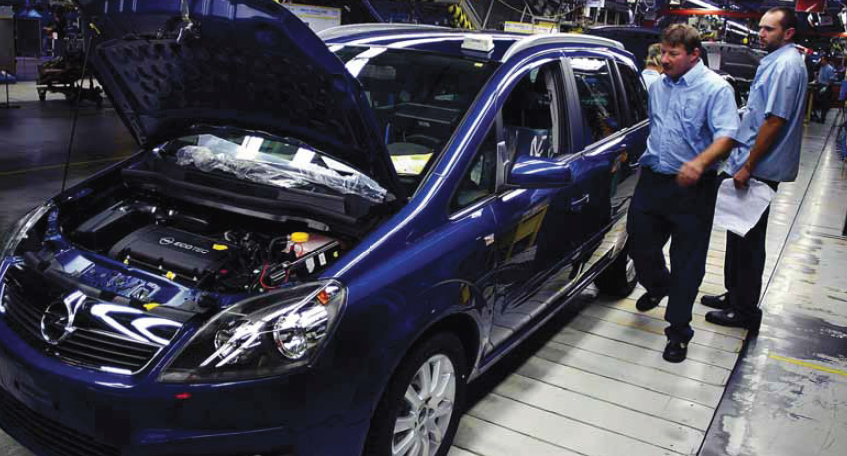 AMS meets GM Manufacturing Poland to discover more about the business strategies which make the most of their central-European location
AMS meets GM Manufacturing Poland to discover more about the business strategies which make the most of their central-European location
The Polish automotive industry has been through some torrid times in the last few years. While appearing to have many of the cost advantages of its near neighbour Russia, but with greater political stability and a more established automobile production infrastructure, the exclusively transplant carmakers with in-country facilities should have been reasonably well insulated from the recent global economic downturn.
Yet even with the relative stability of the currency, the zloty, compared to the recent volatility of the euro, Poland does not always appear to be as attractive a manufacturing base as in the past. AMS spoke with several manufacturing managers and regional experts to gauge the mood of the industry in Poland and to discover the challenges and advantages facing companies setting up plants.
General Motors
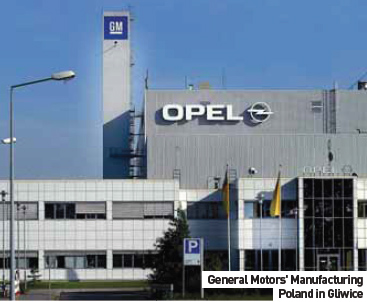 The GM plant in Gliwice, Poland (GMMP) is located in an industrial city of 220,000, selected by the carmaker for its rail and road links, with good routes to regions ranging from Scandinavia to south-eastern Europe, western Europe, Ukraine and on to Russia. Indeed, Gliwice’s export record has been impressive and this is expected to continue with production of the fourth-generation Astra.
The GM plant in Gliwice, Poland (GMMP) is located in an industrial city of 220,000, selected by the carmaker for its rail and road links, with good routes to regions ranging from Scandinavia to south-eastern Europe, western Europe, Ukraine and on to Russia. Indeed, Gliwice’s export record has been impressive and this is expected to continue with production of the fourth-generation Astra.
Like many of its competitors, the plant needs a renaissance. Opel sales fell sharply during the economic crisis, while the uncertainty surrounding GM’s future also affected sales. The Gliwice factory saw production plummet 43.5% 96,700 vehicles in 2009, from 171,640 in 2008, but with strong demand for the new Astra, production is projected to reach 220,000upa.
AMS spoke to Andrzej Korpak, Director of General Motors Manufacturing Poland (GMMP).
AMS: You have been talking about production of Astra 4 requiring a return to three eight-hour shifts per day and hiring 600-700 people by mid-2010. How has this projection panned out?
Andrzej Korpak: The third shift was implemented at the end of May, all the employees we needed for this were hired on time.
AMS: How do you rationalise line-sharing between segments, Zafira and Astra, etc., how do you share assembly and sub-assembly sections of lines?
AK: There is no sharing of more than one production line between models. All three models are on the one line, plus sequencing and pre-assembly are combined.
AMS: In 2008, you said that the drop in production caused by lower demand for vehicles would not result in any job losses, how did this turn out?
AK: The protection of GM employees was one of the most important drivers during the crisis. Since the beginning of 2009,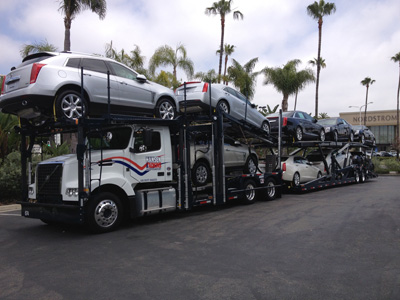 we reduced our operations activity from three to two shifts. This radical decision, forced by lower demand, was not followed by a forced reduction of GMMP employees. During the crisis, 230 employees left our Gliwice plant, most of them in response to our voluntary redundancy programme, while some temporary contracts haven't been renewed. Also, increasing insourcing activities protected us against headcount reduction.
we reduced our operations activity from three to two shifts. This radical decision, forced by lower demand, was not followed by a forced reduction of GMMP employees. During the crisis, 230 employees left our Gliwice plant, most of them in response to our voluntary redundancy programme, while some temporary contracts haven't been renewed. Also, increasing insourcing activities protected us against headcount reduction.
AMS: You have increased production speed many times over the years. What has made this very high-speed production possible, just increased automation or has there been rationalisation of lines and parts on the car? AK: First of all, this greenfield plant was designed to produce 27.5 jobs per hour, the increased speed of 32 jobs was achieved purely by process improvement, including such things as station reduction, parts presentation and process rebalance. Then with Zafira, and the requirement of 35 jobs, the trim and chassis lines were extended to 20 stations. Next, speeds of 38 and then 40 jobs were achieved by continuous improvement of the above-mentioned activities. We have also run a trial of 42 jobs, without any major technical changes.
AMS: GM and Opel have made advances in terms of greater automation; in Poland with its more reasonable labour cost, does this always make sense or do you/can you benefit from the labour cost being lower than in say, Germany?
AK: The lower labour cost still is a serious factor influencing the total manufacturing cost in Gliwice. But there are other advantages. The operation has been organized in a very lean way and still is a benchmark in this area. We continuously improve our cost structure by implementing many employee suggestions. Maintaining a low level of automation in production is not our specific target. The launch of the new Astra 4 caused an increase of automation of the bodyshop, from 30% to 70%.
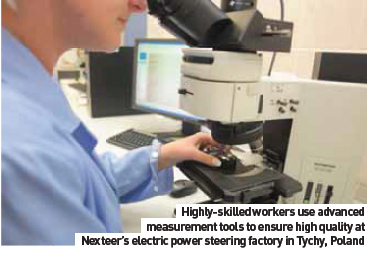 AMS: Fanuc has been your traditional partner in robotics. Do you have many Polish machine or part suppliers and what areas do they work with?
AMS: Fanuc has been your traditional partner in robotics. Do you have many Polish machine or part suppliers and what areas do they work with?
AK: We do not have major Polish machine suppliers. In most cases we have Polish-made jigs, or other straightforward mechanical tooling.
AMS: Are your equipment purchasing decisions always driven from global/senior GM management or are you open to approaches from equipment makers outside the GM global network?
AK: GM has a defined global manufacturing process in order to ensure interchangebility of products and to apply lessons learned. Besides this, GM is always open to reliable and proven technology. We motivate our supplier base to submit alternatives to our proposed technical solutions as part of our inquiry letter (RFQ).
AMS: Your paintshop operations are modern but it is still the slowest part of any plant. How do you balance this with assembly, are you using much painted body storage, etc?
AK: We have our BDC - Body Distribution Centre - where the painted bodies are sequenced to general assembly. The amount of bodies in the BDC is determined by production control department and depends on model split. Usually the volume in BDC is a maximum two hours of production.
AMS: Of all the technologies you have seen in manufacturing over the last few years, what has made the biggest  difference to your lines?
difference to your lines?
AK: In the last few years we implemented servo guns for spot welding applications, instead of pneumatic guns. This allowed us to improve quality of application (constant force regulation during welding), decrease cycle times (gun opening regulation during robot movement) and lower costs (the end electrodes don't have to be replaced so often).
AMS: You have used the integrator Fa. FFT Mücke in the past for specifying and installing equipment. Will you continue to use integrators or design and build new lines and updates using Opel staff?
AK: We make improvements to existing installations with Opel staff. For new production lines we always use integrators or external companies. We will follow this direction in the future.
AMS: And given an unlimited, a 'dream' budget, which technology would you like to bring in to the plant?
AK: As a global idea, it would be very good to implement wireless communication between different machines and control systems. This could save us lot of work in cable installation and prevent frequent breakdowns with broken cables, etc. But currently, wireless communication modules are very expensive and not all of those available are robust enough to work well in an industrial environment. AMS: Gliwice has a reputation as a technical education centre for Poland, what are your links with the university?
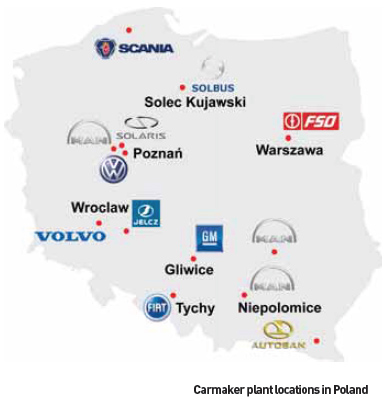 AK: The fact that Silesian Technical University (Politechnika Šlaska) is located in Gliwice was certainly one of the positive factors in GM's decision-making process to base a new manufacturing site here in 1996. Most engineering and managerial staff at GMMP graduated from the university. We also support the Junior Engineer project for final year students at the university. Started in 2003, this still happens every year, with more than 150 participants so far. This is a series of six-month assignments at GMMP, giving the graduates an excellent opportunity to begin their professional career in a modern industrial environment. The university and other technical research centres in Gliwice have also helped us a great deal when we have found problems in our manufacturing process.
AK: The fact that Silesian Technical University (Politechnika Šlaska) is located in Gliwice was certainly one of the positive factors in GM's decision-making process to base a new manufacturing site here in 1996. Most engineering and managerial staff at GMMP graduated from the university. We also support the Junior Engineer project for final year students at the university. Started in 2003, this still happens every year, with more than 150 participants so far. This is a series of six-month assignments at GMMP, giving the graduates an excellent opportunity to begin their professional career in a modern industrial environment. The university and other technical research centres in Gliwice have also helped us a great deal when we have found problems in our manufacturing process.
AMS: The German government has recently rejected GM's request for Opel loan guarantees. Can you say if the Polish government will be likely to help guarantee jobs at Gliwice?
AK: As GM decided to fully support GM Europe financially, no government guarantees are needed. The Polish government treat GM investment as a priority and is always helpful.
Nexteer
Steering a positive path through tough times Electric power steering is a win-win for Nexteer Automotive’s Tychy and Gliwice plants, formerly controlled by Delphi, producing single-pinion electric power steering (EPS) systems for a raft of European-based OEM customers. As part of a 40 million investment made at the end of 2009, an RFID system for production data capture and vision part monitoring was introduced.
AMS spoke to Gonzalo Herrera, head of the company’s Tychy facility, starting off by asking about his customer base. Gonzalo Herrera: At Tychy, we manufacture for Fiat (including Alfa Romeo and Lancia), Ford, Opel and PSA. Since 1998, when we started operations in Poland, we set up plants in Gliwice and Tychy. Fiat is located here in Tychy. At this location we have 1,100 staff, in Gliwice 320, all split between hourly and salaried. We make 1.5 million EPS units per year at each plant.
AMS: Please expand on the RFID track and isolate system you are using.
GH: The RFID system checks assembly of a component, and as each operation is completed, the system writes an update to the status of the part. This gives a pass or fail for each operation.
AMS: Your vision systems, are these used in general assembly checking as well as the electronics sections of the plant?
GH: We use vision systems for some assembly operations but vision is mainly focused on detecting defects in soldered joints in a timely manner.
AMS: Nexteer speaks of making steering systems entirely in-house, but are you buying-in any components from Polish suppliers, European suppliers based in Poland or do parts come from other regions?
GH: Our supply chain buys parts globally. For Poland, we get many parts from around Europe, some from Poland – these are mainly mechanical parts and machined components. In electronics, parts come from Europe, and some aluminium and steel parts come from Asia or the US, depending on specification.
AMS: How do you find the quality of Polish parts/systems suppliers?
GH: Local quality standards are good, suppliers reach our standards and we help them to meet these levels.
br /> AMS: Do you go into their plants/engineering centres and help them to meet your requirements?
GH: Yes, we frequently visit their facilities. Suppliers also visit our plants and our customers join reviews of our lines.
AMS: Steering systems are safety-critical but not always 100% tested by suppliers. What is your position on maintaining ‘safe quality’?
GH: For safety-critical components, we check 100% of our output. A lot of our parts are already inspected by our suppliers before we get them. There are error-proofing and poka-yoke systems in place for all our output. Aside from safety, tight tolerance control is essential to ensure good ‘feel’ to the steering system, we work very hard to maintain this.
AMS: Are you open to new machinery partners/suppliers and if so, how would you like them to approach you?
GH: We are open to new machinery suppliers; if they can reach our standards, we will look at their products. They can approach our purchasing team, find us on the internet, or contact us at the plant. We would invite them to visit the plant and see how we do things.
AMS: How do you find the education, training and competence levels of your workforce in Poland?
GH: From my experience in Mexico, Spain and the USA, I would say that technical skill levels in Poland are high. We hire people from university for engineering and management positions; our hourly workers would have at least completed high school.
AMS: Are you working with any educational establishments, colleges, universities, etc.
GH: Yes, for example, we currently have 27 students working in the plant part-time. Once they graduate, we will offer fulltime opportunities to the right people.
AMS: What percentage of ‘churn’ do you have annually in your line workers and engineering staff?
GH: For hourly people, it is less than 3%. For salaried, it is below 2%. We have loyal staff as the wages are good and the plant conditions are very good. We are ramping up production, so this makes for a very positive atmosphere.
AMS: Which processes or tools have impressed you most in the last few years, whether you are using them or not?
GH: The processes that impress me most are our clean room activities, the soldering and assembly of high-precision parts with constant and reliable quality standards.
AMS: Are you moving or wanting to move to greater use of hard turning and less abrasive machining of hard and hardened steels?
GH: We produce housings and gears here in Tychy, mainly using grinding operations, but we have some Chiron machines for high-speed hard turning.
AMS: Given a ‘dream’ budget, what would you bring in to increase quality, efficiency, etc?
GH: My dream would be to have a communication system that could unite all our plants, our people and our customers, both inside and outside the plants. A continuous open communication protocol.































